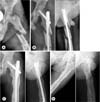Abstract
Purpose
To analyze the clinical and radiologic results of treatments in proximal femoral fracture with Proximal Femoral Nail-Antirotation (PFNA).
Materials and Methods
We retrospectively reviewed the results of 21 cases of proximal femoral fracture treated with PFNA from September 2006 to October 2007 which could be followed up for minimum of more than a year. The mean age was 61.5 (20~88) years old. Male were involved in 12 cases, female in 9 cases. The mean follow up was 14.3 (12~18) months. The Garden alignment index, Cleveland index, tip apex distance were evaluated by post-operative radiologic evaluation and complications of bone union, failure of internal fixation and deformity were evaluated by follow up radiologic findings. Clinical results were assessed by social function score of Jensen and mobility score of Parker and Palmer at last follow up.
Results
All fractures were united and the mean time to bone union was 15.7 (13~18) weeks. Garden alignment index showed good results of above 'good' in 15 cases (71.4%), Cleveland index showed 14 cases (66.4%) positioning in zone 5 and tip apex distance showed 17.81 (±5.65~27.52) mm in radiologic findings. The mean sliding of blade was 1.32 (0.34~2.94) mm in follow up radiologic findings and fracture of distal locking screw area was found in 1 case as a complication. Among 21 cases, the function before injury was completely recovered in 15 cases (71.4%) which were assessed by social function score of Jensen and 13 cases (61.9%) by mobility score of Parker and Palmer.
Figures and Tables
 | Fig. 1For the Cleveland Index. The femoral head (axial view) was divided into nine zone to document the position of the tip of the blade. |
 | Fig. 2The tip apex distance (TAD) is measured between the tip of the helical blade and the cortex of the femural head in the line of the head and neck fragment. The distance has to be measured in the anteroposterior and the axial view. |
 | Fig. 3
(A) Preoperative anteroposterior radiograph of the left hip of a 22 years old man, showing an combined femur shaft and neck fracture.
(B) Postoperative radiograph after fixation with a PFNA.
(C) Radiograph made 6 months postoperatively showing a healed fracture.
(D) Radiograph made 18 months postoperatively after hardware removal.
|
 | Fig. 4
(A) Preoperative anteroposterior radiograph of the left hip of a 72 years old man who slip down, showing an intertrochanter fracture AO type A3-3.
(B) Postoperative radiograph after fixation with a PFNA.
(C) Radiograph made 3 months postoperatively showing a periprosthetic fracture at the distal locking screw.
(D) Radiograph made postoperatively after conversion to intramedullary nail.
|
References
1. Ahn SJ, Park JH. Proximal femoral nail (PFN) for the treatment of the femoral trochanteric fracture. J Korean Fract Soc. 2004; 17:7–12.

2. Bannister GC, Gibson AG, Ackroyd CE, Newman JH. The fixation and prognosis of trochanteric fractures. A randomized prospective controlled trial. Clin Orthop Relat Res. 1990; 254:242–246.
3. Baumgaertner MR, Curtin SL, Lindskog DM, Keggi JM. The value of the tip-apex distance in predicting failure of fixation of peritrochanteric fractures of the hip. J Bone Joint Surg Am. 1995; 77:1058–1064.

4. Boldin C, Seibert FJ, Fankhauser F, Peicha G, Grechenig W, Szyszkowitz R. The proximal femoral nail (PFN) - a minimal invasive treatment of unstable proximal femoral fractures: a prospective study of 55 patients with a follow-up of 15 months. Acta Orthop Scand. 2003; 74:53–58.

5. Cleveland M, Bosworth DM, Thompson FR, Wilson HJ Jr, Ishizuka T. A ten-year analysis of intertrochanteric fractures of the femur. J Bone Joint Surg Am. 1959; 41:1399–1408.

6. Den Hartog BD, Bartal E, Cooke F. Treatment of the unstable intertrochanteric fracture. Effect of the placement of the screw, its angle of insertion, andosteotomy. J Bone Joint Surg Am. 1991; 73:726–733.

7. Friedl W, Colombo-Benkmann M, Dockter S, Machens HG, Mieck U. Gamma nail osteosynthesis of per- and subtrochanteric femoral fractures. 4 years experiences and their consequences for further implant development. Chirurg. 1994; 65:953–963.
8. Han HJ, Yu HJ. The gamma nail for unstable peritrochanteric fractures. J Korean Soc Fract. 1996; 9:76–80.

9. Hardy DC, Descamps PY, Krallis P, et al. Use of an intramedullary hip-screw compared with a compression hip-screw with a plate for intertrochanteric femoral fracutres. A prospective, randomized study of one hundred patients. J Bone Joint Surg Am. 1998; 80:618–630.
10. Ito K, Hungerbühler R, Wahl D, Grass R. Improved intramedullarynail interlocking in osteoporotic bone. J Orthop Trauma. 2001; 15:192–196.
11. Jensen JS. Determining factors for the mortality following hip fractures. Injury. 1984; 15:411–414.

13. Lenich A, Mayr E, Rüter A. Hip replacement after failed internal fixation in patients with proximal femur fracture--a simple procedure? Zentralbl Chir. 2002; 127:503–506.
14. Melton JL 3rd, Ilstrup DM, Riggs BL, Beckenbaugh RD. Fifty year trend in hip fracture incidence. Clin Orthop Relat Res. 1982; 162:144–149.
15. Moon YW, Suh DH, Kang ST, Kwon DJ, Ji YN, Lee KB. The proximal femoral nail for intertrochantericfracture of the femur. J Korean Soc Fract. 2003; 16:29–36.

16. Nuber S, Schönweiss T, Rüter A. Stabilisation of unstable trochanteric femoral fractures. Dynamic hip screw (DHS) with trochanteric stabilisation plate vs. proximal femur nail (PFN). Unfallchirurg. 2003; 106:39–47.
17. Parker MJ, Palmer CR. A new mobility score for predicting mortality after hip fracture. J Bone Joint Surg Br. 1993; 75:797–798.

18. Sommers MB, Roth C, Hall H, et al. A laboratory model toevaluate cutout resistance of implants for pertrochanteric fracture fixation. J Orthop Trauma. 2004; 18:361–368.

19. Strauss E, Frank J, Lee J, Kummer FJ, Tejwani N. Helical blade versus sliding hip screw for treatment ofunstable intertrochanteric hip fractures: a biomechanical evaluation. Injury. 2006; 37:984–989.

20. Whitelaw GP, Segal D, Sanzone CF, Ober NS, Hadley N. Unstable intertrochanteric/subtrochantericfractures of the femur. Clin Orthop Relat Res. 1990; 252:238–245.




 PDF
PDF ePub
ePub Citation
Citation Print
Print






 XML Download
XML Download